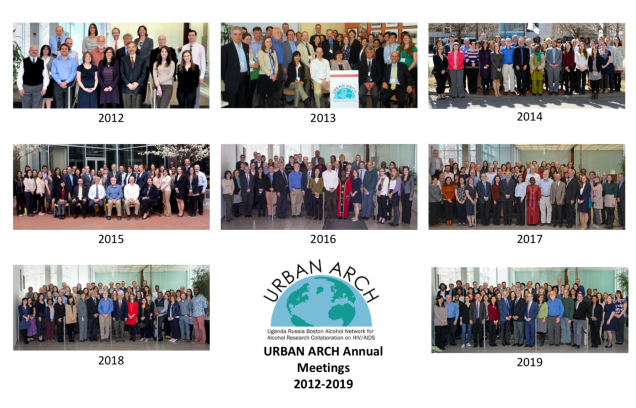Newsletter
Volume 7, Issue 1
January – March 2020
Check out the current issue of URBAN ARCH News, the quarterly newsletter bringing you news on the latest URBAN ARCH and related research.
Highlights from the URBAN ARCH 2020 Annual Meeting In this edition of the URBAN ARCH Newsletter we recap the 2020 URBAN ARCH Annual Meeting that occurred on March 11th and 12th, 2020.
In this edition of the URBAN ARCH Newsletter we recap the 2020 URBAN ARCH Annual Meeting that occurred on March 11th and 12th, 2020.
In this issue, we interview Nneka Emenyonu, DrPH, MPH, Project Director for the URBAN ARCH Uganda Cohort.
Click on the buttons to see what the URBAN ARCH Cohorts and Cores have been working on.
-
Kim T, Ventura AC, Winter MR, Heeren TC, Holick MF, Walley AY, Bryant KJ, Saitz R. Alcohol and bone turnover markers among people living with HIV infection and substance use disorder. Alcohol Clin Exp Res. March 2020.
- Ragan EJ, Kleinman MB, Sweigart B, Gnatienko N, Parry CD, Horsburgh CR, LaValley MP, Myers B, Jacobson KR. The impact of alcohol use on tuberculosis treatment outcomes: a systematic review and meta-analysis. Int J Tuberc Lung Dis. 2020;24(1):73-82.
- So-Armah K, Freiberg M, Cheng D, Lim JK, Gnatienko N, Patts G, Doyle M, Fuster D, Lioznov D, Krupitsky E, Samet J. Liver fibrosis and accelerated immune dysfunction (immunosenescence) among HIV-infected Russians with heavy alcohol consumption – an observational cross-sectional study. BMC Gastroenterol. 2019;20(1):1.
- White LF, Jiang W, Ma Y, So-Armah K, Samet JH, Cheng DM. Tutorial in biostatistics: The use of generalized additive models to evaluate alcohol consumption as an exposure variable. Drug Alcohol Depend. 2020;209:107944.
Article Spotlight
Is Alcohol Consumption Associated with Bone Turnover Markers Among People Living With HIV?
Unhealthy alcohol use and low bone density are prevalent among people living with HIV (PLWH), but their association is unclear. Bone turnover markers (BTM) reflect short-term changes in bone metabolism (i.e., bone formation and/or resorption) and are associated with bone density changes in PLWH. Using prospective data from the Boston ARCH Cohort study, researchers investigated the association between alcohol consumption and BTM in 198 people living with HIV and substance use disorder.
- At baseline, 13% of participants had >20 drinking days in a month with a mean alcohol consumption of 1.93 drinks in a day. Most (72%) of the participants had viral suppression.
- Consuming a higher average number of drinks per day, or >20 drinking days in a month were both associated with lower markers of bone formation.
- No significant associations were detected between alcohol consumption and bone resorption markers.
Comments: In this sample of people living with HIV and substance use disorder, greater alcohol consumption was associated with lower levels of bone formation markers. There was no range of alcohol consumption (“moderate alcohol use”) associated with higher levels of bone formation as other studies have observed. The effect of alcohol on bone formation is particularly important in the setting of accelerated bone resorption that occurs with HIV infection and aging and higher risk of fracture and functional decline.
Reference: Kim T, Ventura AC, Winter MR, Heeren TC, Holick MF, Walley AY, Bryant KJ, Saitz R. Alcohol and bone turnover markers among people living with HIV infection and substance use disorder. Alcohol Clin Exp. March 2020.
Selected NIH Notices and Funding Opportunities
- NIH HIV/AIDS Research Priorities and Guidelines for Determining HIV/AIDS Funding
- Guidance for NIH-funded Clinical Trials and Human Subjects Studies Affected by COVID-19
Click here for more funding announcements related to HIV and alcohol research.
- International AIDS Society (IAS) Conference: To be held virtually July 6-10, 2020.
- College on Problems of Drug Dependence (CPDD): June 20-24, 2020; Hollywood, FL. Late-breaking research submission: April 17, 2020.
- Research Society on Alcoholism (RSA): Cancelled.
Click here for more events and conferences.
